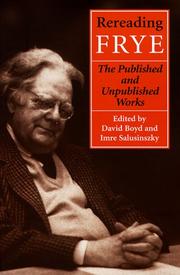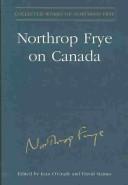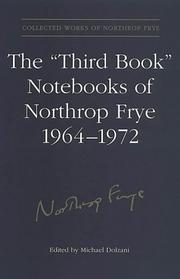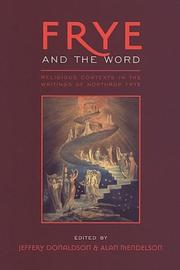| Listing 1 - 10 of 32 | << page >> |
Sort by
|

ISBN: 1281995509 9786611995508 1442679255 9781442679252 080204252X 0802080944 9780802080943 9780802042521 Year: 1999 Publisher: Toronto
Abstract | Keywords | Export | Availability | Bookmark
 Loading...
Loading...Choose an application
- Reference Manager
- EndNote
- RefWorks (Direct export to RefWorks)
"Following Northrop Frye's death in 1991, a large archive of his correspondence, unpublished criticism, and notebooks was deposited with the Victoria University Library at the University of Toronto. This collection of essays, written by a distinguished group of Frye experts, begins the process of reassessing Frye's thought and writings in light of the extraordinary material contained in this archive."--Jacket.
PHILOSOPHY / Religious. --- Frye, Northrop. --- Frye, Northrop --- Frye, Herman Northrop --- Fulai, Nuosiluopu --- Farāy, Nūrtrūp --- Frai, Nort'rop --- فراى، نورتروپ --- פריי, נורתרופ
Book
ISBN: 1443834041 9781443834049 9781443833561 1443833568 Year: 2012 Publisher: Newcastle upon Tyne, UK Cambridge Scholars Publishing
Abstract | Keywords | Export | Availability | Bookmark
 Loading...
Loading...Choose an application
- Reference Manager
- EndNote
- RefWorks (Direct export to RefWorks)
Diane Dubois takes a contextual approach to Northrop Frye's work and claims that it is best assessed in relation to his biographical circumstances. In context and in specific details, Dubois' book seeks to illuminate Frye's œuvre as a personal, lifelong p
Critics --- Literary critics --- Criticism --- Litterateurs --- Frye, Northrop --- Frye, Herman Northrop --- Fulai, Nuosiluopu --- Farāy, Nūrtrūp --- Frai, Nort'rop --- فراى، نورتروپ --- פריי, נורתרופ --- Criticism and interpretation.
Book
ISBN: 1442662085 9781442662087 1442645229 Year: 2012 Publisher: Toronto [Ont.] University of Toronto Press
Abstract | Keywords | Export | Availability | Bookmark
 Loading...
Loading...Choose an application
- Reference Manager
- EndNote
- RefWorks (Direct export to RefWorks)
No mere culmination of the entries in the individual volumes, the index presents a careful re-thinking of each topic to bring out vividly the contours of Frye's thought.
Critics --- Literary critics --- Criticism --- Litterateurs --- Frye, Northrop. --- Frye, Northrop --- Frye, Herman Northrop --- Fulai, Nuosiluopu --- Farāy, Nūrtrūp --- Frai, Nort'rop --- فراى، نورتروپ --- פריי, נורתרופ
Book
ISBN: 1280690682 9786613667625 0776618008 9780776618005 9780776618739 0776618733 9780776606958 0776606956 9781280690686 6613667625 2760315703 9782760315709 Year: 2009 Publisher: [Ottawa, Ont.] University of Ottawa Press
Abstract | Keywords | Export | Availability | Bookmark
 Loading...
Loading...Choose an application
- Reference Manager
- EndNote
- RefWorks (Direct export to RefWorks)
More than fifty years after the publication of Anatomy of Criticism, Northrop Frye remains one of Canada's most influential intellectuals. This reappraisal reasserts the relevance of his work to the study of literature and illuminates its fruitful intersection with a variety of other fields, including film, cultural studies, linguistics, and feminism. Many of the contributors draw upon the early essays, correspondence, and diaries recently published as part of the Collected Works of Northrop Frye series, in order to explore the development of his extraordinary intellectua
Frye, Northrop. --- Frye, Northrop --- Frye, Herman Northrop --- Fulai, Nuosiluopu --- Farāy, Nūrtrūp --- Frai, Nort'rop --- فراى، نورتروپ --- פריי, נורתרופ --- Critics --- Criticism and interpretation.
Book
ISBN: 1322607850 9781322607856 9781443873055 1443873055 Year: 2015 Publisher: Newcastle upon Tyne, England : Cambridge Scholars Publishing,
Abstract | Keywords | Export | Availability | Bookmark
 Loading...
Loading...Choose an application
- Reference Manager
- EndNote
- RefWorks (Direct export to RefWorks)
This chrestomathy is a selection of passages from the previously unpublished writings of Northrop Frye, much of it coming from his notebooks and diaries, which are now a part of his Collected Works (1996-2012). The passages, arranged alphabetically, form a discontinuous series of reflections on diverse topics that are worthy of extracting from their original source. The passages gathered here are aphoristic, insightful, clever, startling, amusing, contrarian, curious, powerful, salty, irrever.
Frye, Northrop --- Frye, Herman Northrop --- Fulai, Nuosiluopu --- Farāy, Nūrtrūp --- Frai, Nort'rop --- فراى، نورتروپ --- פריי, נורתרופ --- Criticism and interpretation.
Book
ISBN: 1442688378 9781442688377 9780802097422 0802097421 9781442692282 1442692286 Year: 2008 Publisher: Toronto
Abstract | Keywords | Export | Availability | Bookmark
 Loading...
Loading...Choose an application
- Reference Manager
- EndNote
- RefWorks (Direct export to RefWorks)
"Although Northrop Frye's first book, Fearful Symmetry (1947), elevated the reputation of William Blake from the status of a minor eccentric to that of a major Romantic poet, Frye in fact saw Blake as a poet (and, consequently, himself as a critic) not of the Romantic period, but of the Renaissance. As such, Frye's meditations on the Renaissance are particularly valuable. This volume collects six of Frye's notebooks and five sets of his typed notes on subjects related to Renaissance literature." "Michael Dolzani divides these notes into three categories: those on Spenser and the epic tradition; those on Shakespearean drama and, more widely, the dramatic tradition from Old Comedy to the masque; and those on lyric poetry and non-fiction prose. The organization of this volume reflects the comprehensive study of Renaissance symbolism in three volumes that Frye proposed to the Guggenheim Foundation in 1949. Frye received a Guggenheim fellowship, but never completed this work; nevertheless, his application, part of which is also included here, is an important document. It not only reveals the outlines of Frye's thinking about literature, it also uncovers his plans for his future creative life during the crucial period between his completion of Fearful Symmetry and his absorption in the writing of Anatomy of Criticism." "In addition to providing insight into Frye's thinking process, the material collected here is of unique importance because much of it touches on topics not fully explored in his other published works."--Jacket
Critics --- Literature --- Literary critics --- Criticism --- Litterateurs --- History and criticism --- Theory, etc. --- Frye, Northrop --- Frye, Herman Northrop --- Fulai, Nuosiluopu --- Farāy, Nūrtrūp --- Frai, Nort'rop --- فراى، نورتروپ --- פריי, נורתרופ --- Canada. --- Literature History and criticism

ISBN: 1282023446 9786612023446 1442677880 9781442677883 0802037666 9780802037664 Year: 2003 Publisher: Toronto
Abstract | Keywords | Export | Availability | Bookmark
 Loading...
Loading...Choose an application
- Reference Manager
- EndNote
- RefWorks (Direct export to RefWorks)
In the third published volume of Canadian literary critic Frye's (1912-91) 77 holograph notebooks, the material is mostly from the 1970s, when he was writing the first of his books on the Bible, The Great Code. However, it begins with Notebook Three from the late 1940s in which he writes primarily on religious themes. It concludes with Notebook 23 from the middle 1980s, written between his first and second book on the Bible; and one from the 1960s devoted largely to his reading of Dante's Purgatorio and the first ten cantos of the Paradiso. Altogether the volume contains 11 notebooks, three sets of typed notes, and a transcription of 24 lectures on The Mythological Framework of Western Culture in 1981-82. Annotation (c)2003 Book News, Inc., Portland, OR (booknews.com).
Bible and literature. --- Literature and the Bible --- Literature --- Frye, Northrop --- Frye, Herman Northrop --- Fulai, Nuosiluopu --- Farāy, Nūrtrūp --- Frai, Nort'rop --- فراى، نورتروپ --- פריי, נורתרופ --- Bible --- Criticism, interpretation, etc.

ISBN: 1282014501 9786612014505 1442682434 9781442682436 9781282014503 0802035426 9780802035424 Year: 2002 Publisher: Toronto
Abstract | Keywords | Export | Availability | Bookmark
 Loading...
Loading...Choose an application
- Reference Manager
- EndNote
- RefWorks (Direct export to RefWorks)
"In the early 1960s, Northrop Frye began keeping notebooks with the aim of creating a critical epic that he referred to as the "Third Book," a project intended as his third major work, following Fearful Symmetry and Anatomy of Criticism. As described by Michael Dolzani, Frye's ambition for the "Third Book" was for it to become no less than a "symbolic guide to the entire universe." The work he envisioned contemplated the ways in which myth and metaphor are the keys to all verbal structures, reaching beyond the hypothetical realm of literature to inform, organize, and control historical, conceptual, political, and perhaps scientific thought." "Although ultimately abandoned, the "Third Book" remains both an essential component of the Collected Works of Northrop Frye and an intriguing text in its own right. Michael Dolzani provides an eloquent introduction that adds an essential unifying frame to the fragmented and complex critical musing which comprise this enormous volume of work. Rather, he has incorporated much useful background material and cross-referencing, enhancing the value of this volume as an important research tool."--Jacket.
Literature --- Appraisal of books --- Books --- Evaluation of literature --- Criticism --- Literary style --- History and criticism. --- Appraisal --- Evaluation --- Frye, Northrop --- Frye, Herman Northrop --- Fulai, Nuosiluopu --- Farāy, Nūrtrūp --- Frai, Nort'rop --- فراى، نورتروپ --- פריי, נורתרופ

ISBN: 1281994677 9786611994679 144267511X 9781442675117 9781281994677 0802088139 9780802088130 0802034152 Year: 2004 Publisher: Toronto
Abstract | Keywords | Export | Availability | Bookmark
 Loading...
Loading...Choose an application
- Reference Manager
- EndNote
- RefWorks (Direct export to RefWorks)
The religious context of Northrop Frye's criticism is virtually inexhaustible in its reach and implication. Frye and the Word draws together leading scholars in the fields of literary studies and hermeneutics, religious studies, and philosophy to construe and debate the late thought and writings of Northrop Frye in their spiritual dimension. The volume provides the first full account and evaluation of the legacy of Frye's works on the Bible and literature, in relation to Frye's work as a whole and to current trends in literary criticism and religious studies. Frye's trilogy, The Great Code, Words with Power, and The Double Vision, both showed him to be a radical Blakean visionary and carried him forward into an urgent engagement with the imaginative and spiritual dimension as expressed in language, myth and metaphor, tools of recognition, and revelation. Frye struggled to understand and articulate how the Bible enjoyed for reasons still to be fully appreciated in their literary context an apparently unequalled spiritual and cultural authority, and what this authority could tell us about our primary concerns as human beings and our still unrealized potential for fulfillment. This collection, then, is about Frye's own engagement with words and the Word, with secular and sacred scripture about a unifying principle that lies often unrecognized, if everywhere manifest, in the spiritual and imaginative dimensions of language.
LITERARY CRITICISM / European / General.
---
Frye, Northrop
---
Frye, Herman Northrop
---
Fulai, Nuosiluopu
---
Farāy, Nūrtrūp
---
Frai, Nort'rop
---
فراى، نورتروپ
---
פריי, נורתרופ
---
Religion
---
Criticism and interpretation
---
Hamilton
Book
ISBN: 1442687185 9781442687189 9781442641600 1442641606 Year: 2011 Publisher: Toronto
Abstract | Keywords | Export | Availability | Bookmark
 Loading...
Loading...Choose an application
- Reference Manager
- EndNote
- RefWorks (Direct export to RefWorks)
Graham contends that it was the method of Frye's thinking - his dialectic ability to see opposing concepts as a unity rather than a dichotomy - that allowed him to transcend binary constructs and formulate new conclusions and questions about literature, politics, and society.
LITERARY CRITICISM / General. --- Frye, Northrop --- Frye, Herman Northrop --- Fulai, Nuosiluopu --- Farāy, Nūrtrūp --- Frai, Nort'rop --- فراى، نورتروپ --- פריי, נורתרופ --- Criticism and interpretation. --- Political and social views.
| Listing 1 - 10 of 32 | << page >> |
Sort by
|

 Search
Search Feedback
Feedback About UniCat
About UniCat  Help
Help News
News